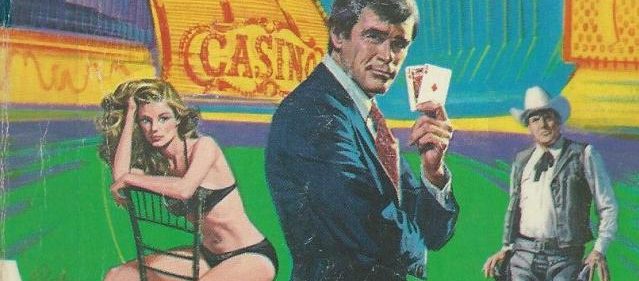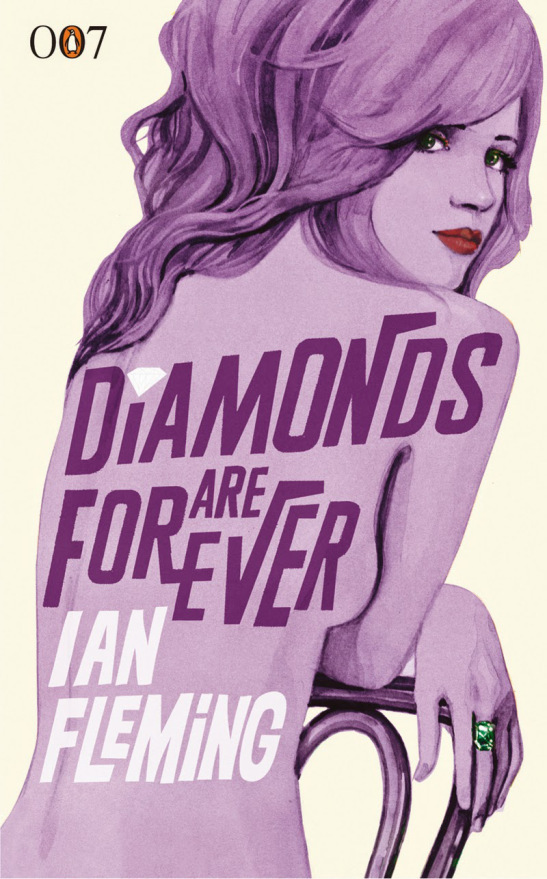

“In the east, the sky was pearly grey and iridescent, like a toy balloon filled with cigarette smoke, and among the shrubs the mocking birds were beginning their first song. Blue smoke rose straight up in the air from the fires in the camps behind the stables and there was a smell of coffee and wood-smoke and dew.”
In the fourth Bond novel, Diamonds are Forever, Ian Fleming mines themes similar to those of the first three. There is still plenty of gambling, descriptions of alcoholic beverages, womanizing, and adoration of upper class pastimes. Compared to other Bond outings, the action here is quite muted and the villain surprisingly nebulous, and the plot is flimsy. The character of James Bond, developed throughout the series thus far, remains intact, and the story, while unsophisticated, is compelling and easy to read. The novel was loosely adapted into a film of the same name in 1971 starring Sean Connery.
Bond meets with M, who briefs him on a diamond smuggling operation that is affecting the British economy. Bond then replaces a courier with the objective of working his way up the pipeline. He briefly uses a fake identity, but drops it when he meets his partner, Tiffany Case, who helps him transport diamonds from Sierra Leone to the United States by hiding them in hollowed out golf balls. Fleming describes the diamonds with almost as much rapture as he describes the rocket in Moonraker.
Bond put down the piece of quartz and gazed again into the heart of the diamond. Now he could understand the passion that diamonds had inspired through the centuries, the almost sexual love they aroused among those who handled them and cut them and traded in them. It was domination by a beauty so pure that it held a kind of truth, a divine authority before which all other material things turned, like the bit of quartz, to clay. In these few minutes Bond understood the myth of diamonds, and he knew that he would never forget what he had suddenly seen inside the heart of this stone.
The plot is meandering, and Bond spends a large chunk of the novel simply trying to collect payment from the mob for his smuggling job. He is first sent to Saratoga, where he will bet a small sum on a fixed horse race to collect his earnings. Soon after arriving in Saratoga, Bond runs into his old buddy Felix Leiter, who now sports a hook for a hand and a prosthetic leg after being mauled by sharks in Live and Let Die and has taken a job with Pinkerton instead of moving behind a desk for the CIA. It just so happens that Leiter is after the same gang that Bond is looking into. It is kind of strange because while Leiter and Bond are friends, Bond is undercover while Leiter is a known agent. Nevertheless, they work together to foil the fixed race.
Bond agrees to pay off the jockey, Tingaling Bell (one of several silly nicknames that Fleming gives his characters, even calling attention to the absurdity—e.g. Boofy, Windy, Shady Tree), and heads to a facility offering hot mud baths to meet him. Two gang members intrude and harass the jockey for throwing the race. They dump mud onto his face as the rest of his body remains submerged beneath hundreds of pounds of it.
Once the horse race payment plan fizzles out (because of Bond and Leiter), Bond is instructed to go to Vegas and win his earnings in fixed games of blackjack dealt by Tiffany Case, who rapidly becomes Bond’s love interest, despite scant romantic development between them and her own position in the criminal underworld. As with the previous Bond outings, this one too spends many words on descriptions of gambling. First the horse race, then blackjack; but Fleming takes a dig at the mindless slot machines.
And the gamblers stood and tore at the handles of the machines as if they hated what they were doing. And, once they had seen their fate in the small glass window, they didn’t wait for the wheels to stop spinning but rammed in another coin and reached up a right arm that knew exactly where to go. Crank-clatter-ting. Crank-clatter-ting.
And, when there was the occasional silvery waterfall, the metal cup would overflow with coins and the gambler would have to go down on her knees to scrabble about under the machines for a rolling coin. For, as Leiter had said, they were mostly women, elderly women of the prosperous housewife class, and the droves of them stood at the banks of machines like hens in an egg battery, conditioned by the delicious coolness of the room and the music of the spinning wheels, to go on laying it on the line until their wad was gone.
Bond is taken to Spectreville, a restored Western ghost town owned by Seraffimo Spang, one of the leaders of the Spang Mob. The only way to get there is by train, another artifact which Bond again describes with awe, like the diamonds and the Moonraker.
It was probably the most beautiful train in the world. The engine was one of the old locomotives of the ‘Highland Light’ class of around 1870 which Bond had heard called the handsomest steam locomotives ever built. Its polished brass handrails and the fluted sand-dome and heavy warning bell above the long, gleaming barrel of the boiler glittered under the hissing gaslights of the station. A wisp of steam came from the towering balloon smoke-stack of the old wood-burner. The great sweeping cow-catcher was topped by three massive brass lights—a bulging pilot beam at the base of the smoke-stack and two storm lanterns below. Above the two, tall driving wheels, in fine early Victorian gold capitals, was written The Cannonball, and the name was repeated along the side of the black-and-gold painted tender piled with birch logs, behind the tall, square driver’s cabin.
Bond is tortured and in his half-conscious state he imagines himself underwater, being pulled against the coral—a memory of the climactic rescue mission in Live and Let Die. Bond and Tiffany Case are aided in their escape by Leiter, and the pair depart for London on an ocean liner. After another heroic episode on the boat, Tiffany gives Bond the details of the diamond operation. The smuggling out of the mines is achieved by a dentist bribing miners to carry them out in their mouths; he then surgically removes the diamonds during smugglers’ appointments with him. Bond follows the pipeline—which by now is collapsing—and finishes off the other Spang brother, the mysterious “ABC” who had been Tiffany Case’s controller.
Plotwise, Diamonds Are Forever is probably the weakest Bond novel yet. However, Fleming’s prose is noticeably more considered, and his vocabulary seems to have broadened as well (although he oddly chooses to both use the f-word and censor it in-text). He loves describing his aristocratic fancies, but he gives consideration to his research subjects as well. The opening, in which a desert scorpion carefully hunts its prey, is an unexpected and flavorful addition. While the plot is light and structurally messy, the realism conveyed by Fleming’s descriptions of race stables, casinos, the mud bath, etc. (all real places that Fleming visited, if I’m not mistaken) and the increased level of character development give the novel additional weight. Tiffany Case, the first woman that Bond has really fallen for since Vesper Lynd in Casino Royale, is probably the most developed female character thus far in the series. She was gang-raped by Mafia members at sixteen years old and her standoffish attitude toward Bond is due to her lifelong fear of opening herself up to any man at all.
I think there are two main things that hamper Diamonds Are Forever. First, there are simply too many locations for the length of the book—London, Sierra Leone, New York City, Las Vegas, etc. I know that the locations are mostly real, but they don’t all need to be included. Second, there is a distinct lack of a megalomaniacal villain. Casino Royale had Le Chiffre; Live and Let Die had Mr. Big; and Moonraker had Sir Hugo Drax. Each of those villains was featured prominently, but the Spang brothers (and sidekick Winter) take turns occupying the role of antagonist, but none of them ever really take center stage—which is fine, but nothing really took the place that was vacated by de-emphasizing the main villains. Fleming tries to make some profound remarks in passing—touching on the transitory nature of life and the uncertainty of marriage—but they are mostly trivial and don’t do much.
Diamonds Are Forever introduces some new and welcome additions to Fleming’s writing style; namely, increased character development, and a more intentional, literary prose. He quotes Ralph Waldo Emerson and pulls the reader into the world by mentioning several musical styles and the vague memories they evoke for Bond. However, its loose plot and needless globetrotting, as well as its lack of a serious antagonistic match for Bond make it feel like “just another Bond novel.” If the improvements shown here can be matched with the elements of previous novels that Diamonds is not quite on par with, then Fleming could have a legitimately good book on his hands.